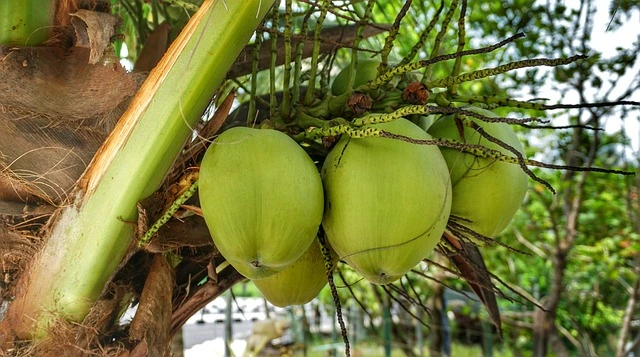From this ultimate guide on coconut farming, get to know about origin, area & production, climate, soil, varieties, irrigation, fertilizers, etc. to get higher yields.
Cocos nucifera is the scientific name for the coconut tree. Coconut tree is also known as Kalpavriksha because every part of this tree is useful to mankind in some way or the other. From nutritious food crop to water, oil, shell, fiber, wood, leaf etc. obtained from coconut tree, everything is beneficial to meet the diverse needs of the people.
Table of Contents
Area & Production
In the year 2021, Indonesia became the largest producer of coconut in the world. The total coconut production by Indonesia was 17.16 million metric tonnes. In the same year, Philippines was the second largest producer of coconut in the world, accounting for about 14.7 million metric tonnes of coconut.
India is the third largest coconut producer in the world with production of about 14.3 million metric tonnes of coconut. This is followed by Sri Lanka, Brazil, Vietnam, Papua New Guinea, Mayanmar, etc.
Coconut Farming Guide
Soil & Climate
The coconut tree grows in different types of soil and in different climates. Coconut is a tropical crop. You can cultivate them up to an altitude of 1000 meters above sea level in the equatorial region. However, it is mostly cultivated between 20 degree south latitude and 20 degree north latitude.
It requires climate with high humidity. Well distributed rainfall up to 200 to 300 centimeters per year is favorable for coconut growth. You can cultivate cocunut successfully with proper irrigation. Coconut grows well in Makharli, coastal sandy alluvial, red soils and improved soil suitable for coconut.
Varieties Of Coconut
There are three types of coconut trees on the basis of growth and size characteristics; Tall, dwarf and hybrid.
- Dwarf variety: The dwarf variety starts fruiting in the third or fourth year after planting. The dwarf variety is mainly grown for the production of hybrid seed and coconut fruit.
The major dwarf varieties are: Chavakkat Orange Dwarf (COD), Chavakkat Green Chouni (CGD), Malayan Green Vani (MGD), Malayan Orange Dwarf (MOD), Malayan Yellow Yoni (MYD). and Ganga Badan (GB).
- Tall Varieties: Tall varieties are extensively cultivated in all the coconut growing regions of the world. The name of the country or region of origin is added to the name of the crop for identification. Tall variety starts bearing in 7-8 years after planting.
The commonly cultivated tall varieties are West Coast Long (WCT), East Coast Long (ECT), Lakshadweep Ordinary, Lakshadweep Micro, Tiptur Long, Andaman Ordinary and Philippine Ordinary.
- Hybrid variety: Coconut plants produced by crossing tall and dwarf trees show good quality in growth and production. It starts bearing fruit in four to five years after planting.
Production Of Coconut Seed
Coconut has a lot of genetic variation and is grown only from seed. Apart from this, due to coconut being a multiple crop, the quality of the tree will be known only after seven-eight years of planting. Therefore, the selection and use of good planting materials are considered important in coconut farming.
Coconut trees produce continuously for more than 80 years and sustainable production is achieved for 10-15 years after planting. If the material is of poor quality, the orchard will prove to be unprofitable and the farmers will end up with losses. Therefore, more emphasis should be given on the selection and use of the right planting materials.
Selection Of Mother Tree
Genetic variation is found in the coconut tree and plants are produced only by seeds. That’s why the selection of seeds is of utmost importance in this. Therefore, select healthy and good trees are which are fruitful and give fruits continuously.
Select disease free trees of 20-60 years of age as mother trees. It must have at least 12 fruit bunches that give at least 80 coconuts per year. These trees should have at least 30 leaves and the peduncles should be short and strong.
Aggregation Of Seeds
The seeds should be collected from the mother trees having the following characteristics in the months of January to May.
- Seeds should be of medium size.
- Only well ripe coconut should be selected.
- The weight of peeled coconut should be 500-600 grams and that of peel should be 150 grams.
- Bad or unripe coconuts should be discarded.
Storage Of Seeds
Store collected seeds in such a way that water does not enter them. 8. cm Make a layer of thick soil and place the coconut upwards on it and keep the seed fruits one above the other. Soil should also be put on top of each coconut. Practice sowing only after the husk has dried.
Coconut Nursery Preparation
For nursery preparation, select a shady place with proper drainage. Prepare beds of 1-1.5 meters wide & of suitable length. Leave 75 centimeres distance between beds & 30 centimetres distance between rows. Coconuts can be sown in five rows on one bed. Seeds can be sown vertically or horizontally. The months of May and June are suitable for this.
If the nursery is in the open space, shade should be given. In summer, irrigation should be done once in two days. If there is an outbreak of termites, use the insecticide Chlorpyrifos. If the outbreak of fungus is found, then spray one percent Bordeaux mixture.
Selection Of Plants
9 months to one year old seeds with the following qualities are used for planting.
- Select early sprouting plants.
- A one-year-old plant should have at least six leaves.
- The neck of the plants must be 10-12 centimetres thick.
- The leaves of the plant shoul be emerging soon.
- Select healthy plants that grow well and are free from diseases and pests.
Land Selection & Prepartion
Coconut farming requires deep (not less than 1 m depth) and well drained soil. Shallow soil with hard rock bottom, low land with water logging and heavy alluvial soil etc. are not suitable for coconut cultivation.
The size of the pit for planting depends on the soil type and groundwater level. In loamy soil with low ground water level pits of 1× 1× 1 metre is recommended. In the soft soil containing solid stone below, large pits of 1.2× 1.2× 1.2 metres are required.
After preparing the pit, it can be left open for a short period so that sufficient amount of sunlight can reach the soil which is helpful in killing the harmful micro-organisms.
After this, fill the pit with a mixture of top soil, sand and neem cake (from 250 g to 500 g per pit) up to 60 cm height from the bottom. The roots of trees planted on the upper surface remain on the upper surface and are visible outside the soil, due to which the trees are prone to drought.
In sandy soil and in areas prone to long periods of drought, it is beneficial to bury two layers of peel at the bottom of the pit with the inner side facing upwards before putting the soil-sand mixture in the pit. It absorbs moisture during the rainy season and releases water to the small plants during the dry season.
In areas with gravelly soil, the soil becomes soft by adding 2 kilograms of salt at the bottom of the pit.
Planting Distance
The distance between the trees has special importance in coconut cultivation. Generally 7.5 x 7.5 metres distance between trees is recommended. 175 plants can be planted in one hectare if plants are planted in square method leaving this distance between the trees.
By adopting triangular method, aditional 20 to 25 plants can be planted. In single row system, Saplings can be planted by leaving a distance of 5 to 5.5 metres between two plants on a row & 9 to 10 metres between the queues.
Plantation Time & Method
Planting time depends on the local climatic condition, so it varies from state to state. However, if there is no water logging and well drained soil, then generally the proper time for planting is with the onset of monsoon and in this way the plants will take root quickly. However, if assured irrigation facilities are available, planting can be done one month before the onset of rains.
In low lying areas with long standing water, planting can be done after monsoon. Before planting saplings in sandy areas, if coconut peel is buried in the soil, then the plant will grow well.
After filling the pit to the desired height, the coconut sapling is planted in a small pit made in the middle of each pit. At the time of planting, care should be taken that the neck of the plant (the part where the plant joins the fruit) should not be covered with soil.
After planting, tamp the soil around the plant well without causing any damage to the neck. In very windy areas, the plant should be given proper support so that the growth and development of the roots does not get hampered by the movement of the plant in the wind.
Coconut Plant Care
After planting, the coconut plant needs constant protection and care, especially while growing root, the soil between these trees should be plowed once in a year, which not only increases the flow of air in the soil, but also maintains moisture in it. It is necessary to provide shade to the plants and irrigate them in summer.
Giving 45 liters of water once in four days is a suitable method for sandy soil. Water-draining facilities should be provided in water-logged areas. Weeds should be removed from the pits in time. Do not let the soil get frozen on the neck of the plants by flowing with rain water.
Inorganic & Organic Fertilizers
Being a perennial crop, the coconut tree continuously extracts a large amount of nutrients from the soil. Therefore, if fertilizers are not given in a balanced way, the nutrients are lost from the soil. Tree growth is stunted and yield is reduced. Therefore, it is necessary to fertilize the tree regularly every year.
Each fruit tree should be given 500 grams of Nitrogen (N), 320 grams of Phosphorus (P,05) and 1200 grams of Potash (KO) every year.
To get the recommended amount of nutrients, add 1 kilogram Urea, 1.5 kilograms Rock Phosphate or 2 Kilograms Super phosphate and 2 kilograms muriate of potash. Young trees should be given nutrients at the rate of 1/10th of the full dose in the third month after planting, one-third of the full dose after one year, two-thirds after the second year and full dose from the third year onwards.
One-third of the recommended fertilizers are applied 1.8 m from the bottom of the tree in the month of May-June. Make a basin at a distance of 100 meters and sprinkle it in it and mix it in the soil.
At a distance of 1.8 m around the bottom of the tree in the months of August-September; Put green manure or compost in the deep basin of 25 centimetres at the rate of 50 kilograms to each tree. Pour the remaining two-thirds of chemical fertilizer over it and cover it with soil.
Apart from chemical fertilizers in acidic soil, one kg of lime or dolomite is required to be added. In the months of April-May, sprinkle it in the basin of coconut tree and mix it in the soil.
Organic Fertilizers
If you want to practice organic coconut farming, use cow manure, compost, green manure, earthworm manure etc. as organic fertilizers. As soon as the monsoon starts, sow 100 grams seeds of any pulse green manure in the basin of the coconut tree.
After about four and a half months, when the plants start flowering, uproot them and put them in basin & cover them. In this way, by growing green manure crop in the basin, about 15 to 25 kilograms of green manure and through it 100 to 200 grams. until nitrogen is made available.
Irrigation
Coconut orchard should be irrigated regularly. The interval of irrigation is kept about one week. If there is proper irrigation system, irrigation should be done by putting silt of the pond on the coconut basins, so that sufficient moisture remains in them. Coconut shells or coconut leaves are deposited in the basins to further increase the moisture.
In summer there is a shortage of water in the coconut trees. Due to this, falling of immature fruits, breakage of petiole etc. is seen. This gradually reduces the production of coconut. To solve this problem coconut trees should be irrigated.
It has been found beneficial to give 200 liters of water once in four days while irrigating the basins. The method and interval of its irrigation depends on the availability of water in the particular area, the type of soil and the climate. Humid and natural drainage land has its special importance for the production of coconut.
In case of scarcity of water, use drip irrigation and the rate of irrigation should be at least 80 to 100 liters per tree per day in adult trees. In coconut growing areas where the rainfall is below 1000 mm. but, irrigation facilities are available, economic cultivation of coconut is possible.
Drip irrigation is a very appropriate irrigation method, which is adopted in most areas, if there is a proper system of irrigation. While only 30 percent of the water is used in pond irrigation, about 90 percent of the water is used in drip irrigation. In drip irrigation, water is given drop by drop at a slow rate.
Fertigation
Fertigation is the delivery of fertilizers to plants along with water in drip irrigation. Adopting this method is very beneficial. With this, the quantity of recommended fertilizers can be halved as well as the working efficiency of fertilizers can be increased. In this, urea for nitrogen, phosphoric acid for phosphorus and muripate of potash should be used for potash.
Fertilizer can be applied in six monthly installments in the period from December to May. 91 grams of urea per tree, 33 ml. Phosphoric acid and 167 grams of muriate of potash should be given every time.
Weeding & Hoeing
Weeding is required to avoid weeds. By doing this, weeds will be controlled, as well as it will be effective in moisture conservation. Regular weeding is essential in coconut gardens to get maximum production.
To prevent the outbreak of unnecessary weeds, cover crops are sown which also increase soil fertility by reducing unnecessary weeds and they help in soil and water conservation. The nutrients of the soil can be increased by cultivating green manures like flax, Sesbania and Pigeon pea in the coconut garden.
Green manure crops are planted between coconut trees before monsoon. Green manure crops are sown in the basins of trees and when they flower, they are uprooted and mixed with the soil.
Mixed Cropping In Coconut
Crops such as pineapple, banana, groundnut, chili, sweet potato, cassava and a variety of vegetables can be cultivated. Cocoa, cinnamon, black pepper, clove, nutmeg etc. can be grown as a mixed crop between adult trees(10 to 25 years). Nevertheless, adequate fertilizers and water should be given separately for these mixed crops.
It is beneficial to cultivate different types of fodder grasses in the coconut garden. Cultivation of pulse fodder grass Stylo canthus persillus as well as hybrid Napier, Guinea gham etc. in coconut garden is very beneficial.
Four or five milch cows can also be reared by cultivating the above fodder grasses in one hectare coconut garden. Using the cow dung obtained from them in the garden itself, there is a big increase in the fertility of the soil and it inceases Farmer’s income. The family members also get additional employment opportunities.
Harvesting Of Coconut
After opening of spathe, coconut becomes mature after 12 months. Nuts of 11 months age can be harvested to get good quality of the coire fibre. However, harvesting of coconuts mainly depends on climate, variety and yield of the trees. In well maintained coconut orchard, harvesting is done once a month.







Good article, but we have a disease on coconuts as patch in coastal area and the size has also reduced so much. This happened after the 96 cyclone. It became common in our area any solution
Hi, to get personalized guidance, please share pictures of the diseased portion and the name of your village/town/city and state. You can connect with Agriculture Review on Facebook or Instagram.